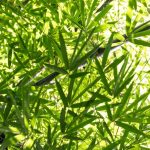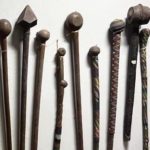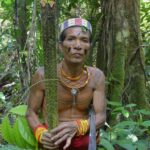The Mentawai people use poison on their arrows to hunt game. In previous articles on this website, we discussed the Mentawai people’s hunting methods. Then, we presented an actual hunt for Flying foxes. We then discussed the longbows used on these hunts, the arrows used for different animals, and quivers. In the following section, we will discuss the manufacture of Mentawai arrow poison.
Before starting this article, one important fact has to be remembered. The Mentawai people don’t have a written language and only communicate orally. Therefore, a variety of different transcriptions of this vernacular language exist. I wrote the plant names in this article as my Mentawai interpreter told me and jotted them in my notebook. However, it can be that different authors write different plant names for the same species. Consequently, and to avoid confusion, I have added the scientific names of the plants for clarity.
Mentawai poison ingredients
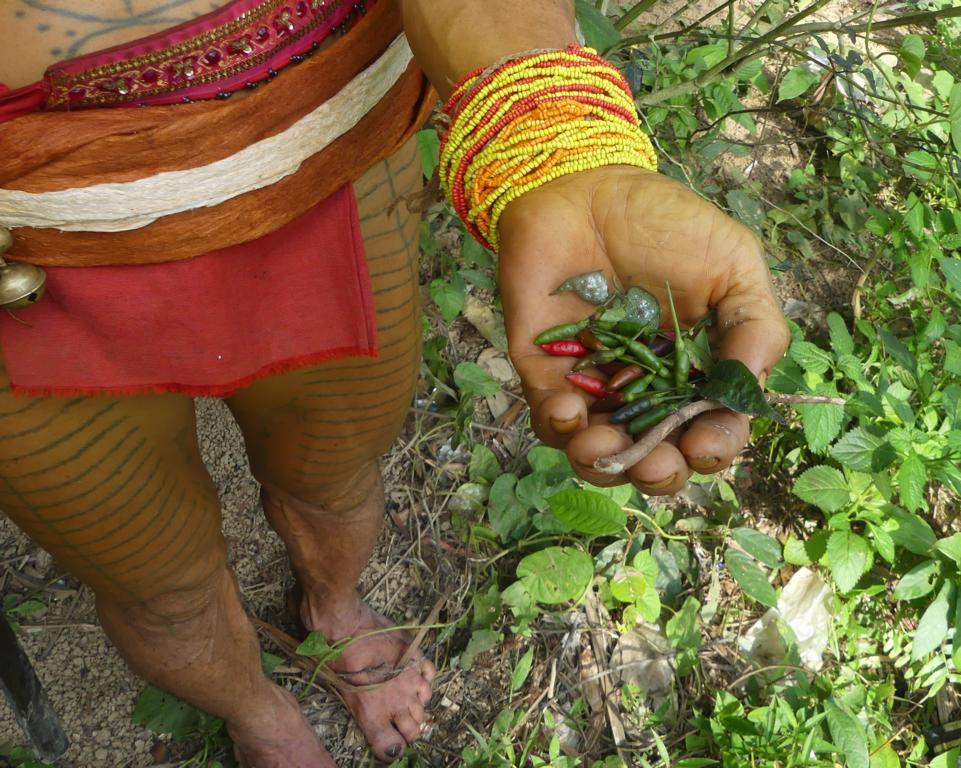
When visiting the Mentawai people in December 2023, around 1000 tribal members were still living permanently in the hilly forests of Siberut Island. Each family’s Uma (longhouse) is at least 30 minutes from the next neighbor. Therefore, these people are spread over a wide area. Because of this seclusion, each family adapted their poison recipe over time, which proved most efficient for their local circumstances. Because of this reason, many Umas use slightly different recipes for their preferred arrow poison. In the following, I will describe the three ingredients Aman Aru uses in the Buttui area, representing the classical composition.
Daggi (also: Raggi); Tabernaemontana peduncularis
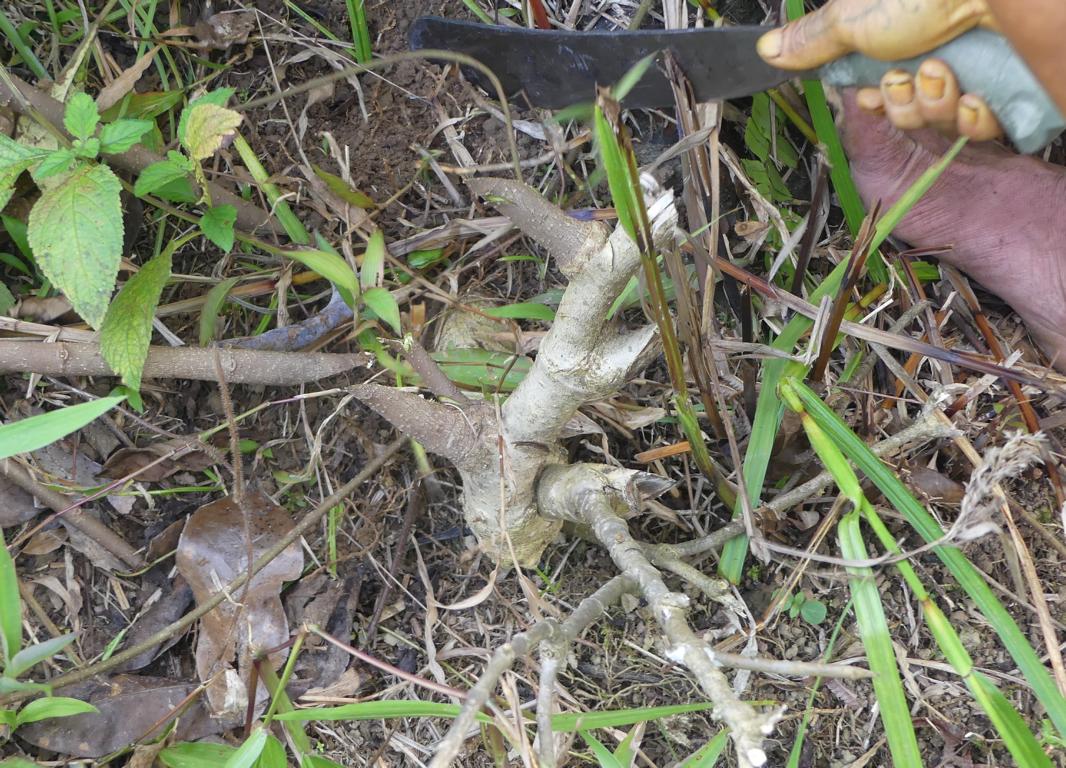
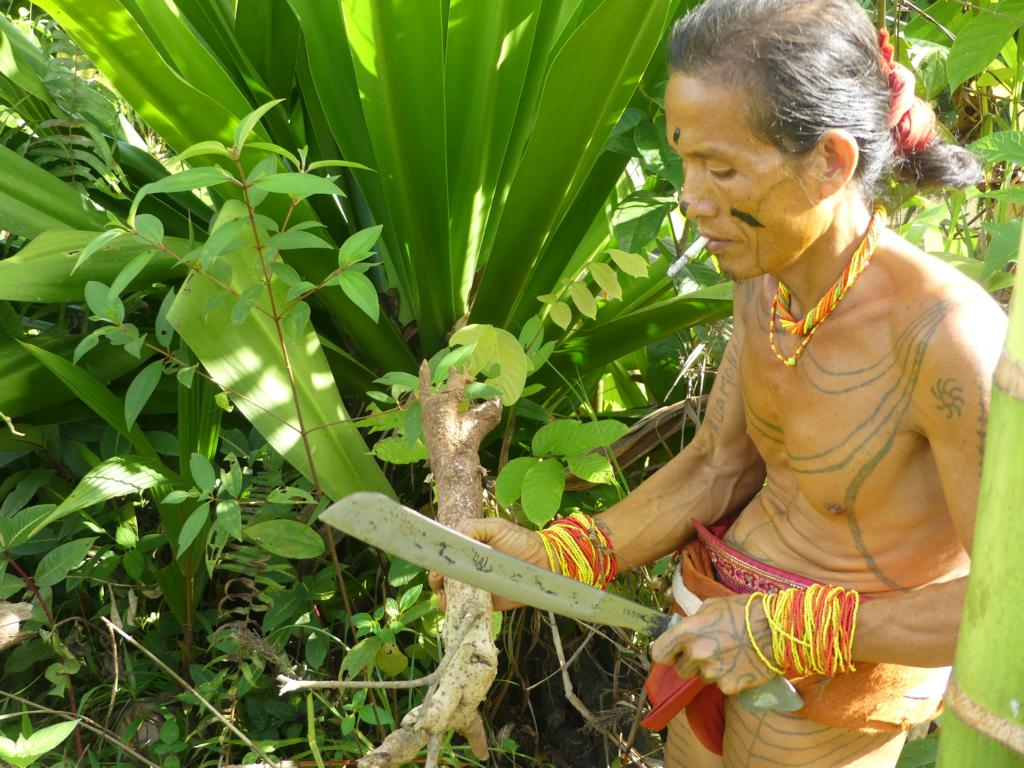
Misinterpretation of the scientific name
Most authors describing Mentawai arrow poison named the Moraceae tree Antiaris toxicaria Lesch as Daggi. Latex of Antiaris toxicaria is the basis for the blowpipe dart poison of the Orang Asli people in Malaysia and Dayaks in Kalimantan. But its leaves are not toxic. However, the Daggi plant’s leaves, bark, and wood can be used for poison-making. The ‘Herbarium Bogoriense,’ the largest herbarium in Southeast Asia, finally found 1998 that Daggi is Tabernaemontana peduncularis and not Antiaris toxicaria. The occurrence of Antiaris toxicaria in Siberut has not even been confirmed. See Herwig Zahorka’s article here.
I have seen the tapping of A. toxicaria latex in Malaysia and the collection of T. peduncularis sap at Siberut. Both tree saps look different; only the dried poisons appear visually similar and are highly water-soluble. Only mature Ipoh (A. toxicaria) trees with a trunk diameter of at least 30 cm provide poisonous latex with the required strength, not younger or smaller ones. These trees are about 20 meters high. In contrast, Daggi is collected from a bush not higher than 2 meters!
I want to specifically add this information, as up to today, the widespread misinformation lingers that Ipoh (A. toxicaria) poison is used by Mentawais. It is not. Mentawais are using Tabernaemontana peduncularis and call it Daggi.
Use of Daggi
Daggi’s function is to make the animal tired after being shot. It can be touched and handled, but contact with open wounds or the human body’s bloodstream must be avoided. It acts purely parenterally.
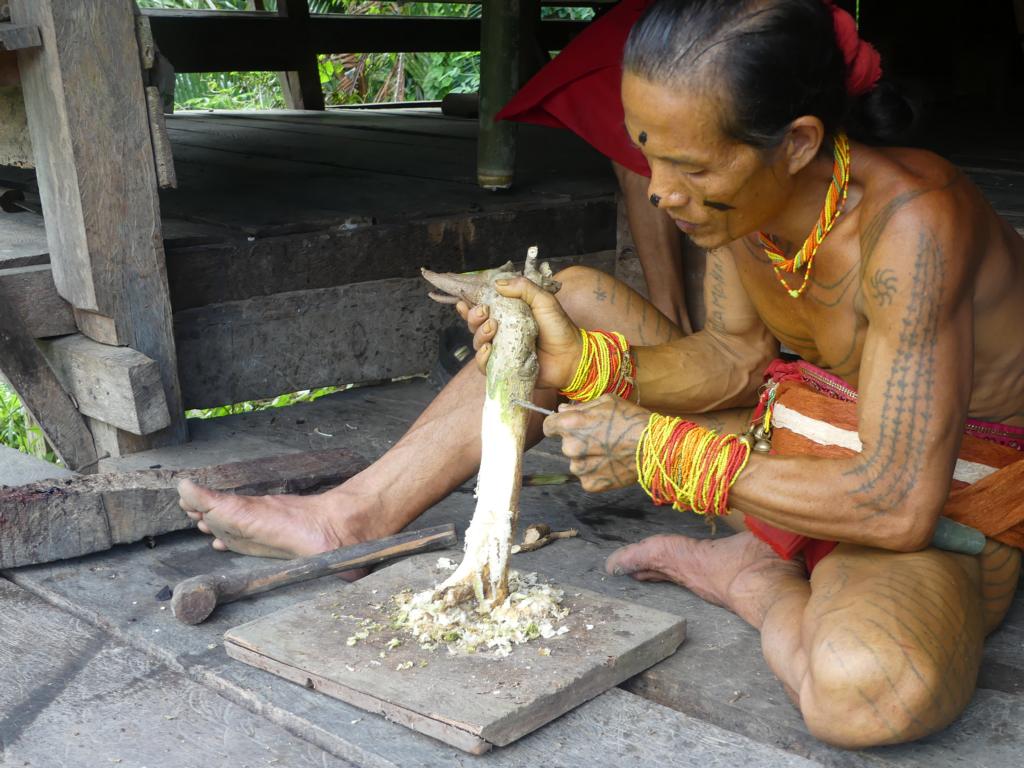
Preferably, the bark of a thick wood stump from a T. peduncularis shrub will be scraped off. Young plant shoots do not contain suitable sap. Only the white inner bark of mature wood will be used, not its brown outer bark.
Poisonous chemical compounds of Daggi
Zahorka reported, see here, that six known alkaloids were isolated from the Daggi stem bark. Among them are powerful heart poisons with paralyzing effects comparable to Strophanthin.
Laining (also: Laingi, or: Langgit); Derris elliptica
Laining is a climber commonly called tuba root (Derris elliptica). Only the roots contain a high amount of poison, not the leaves. Although the roots are very poisonous, they can be touched. The effect only takes place when entering the victim’s bloodstream.
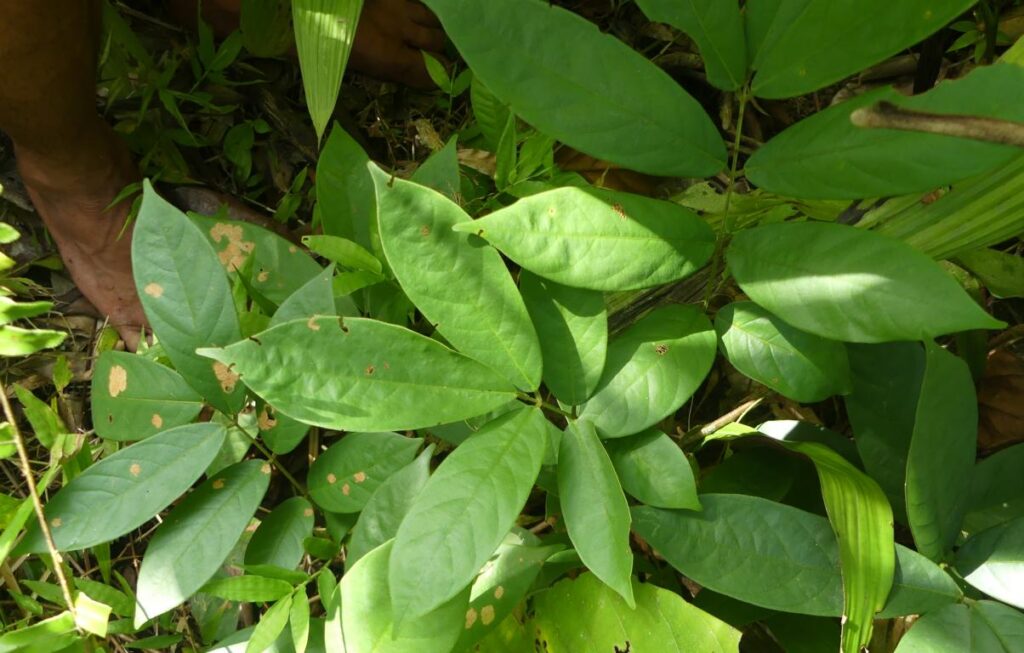
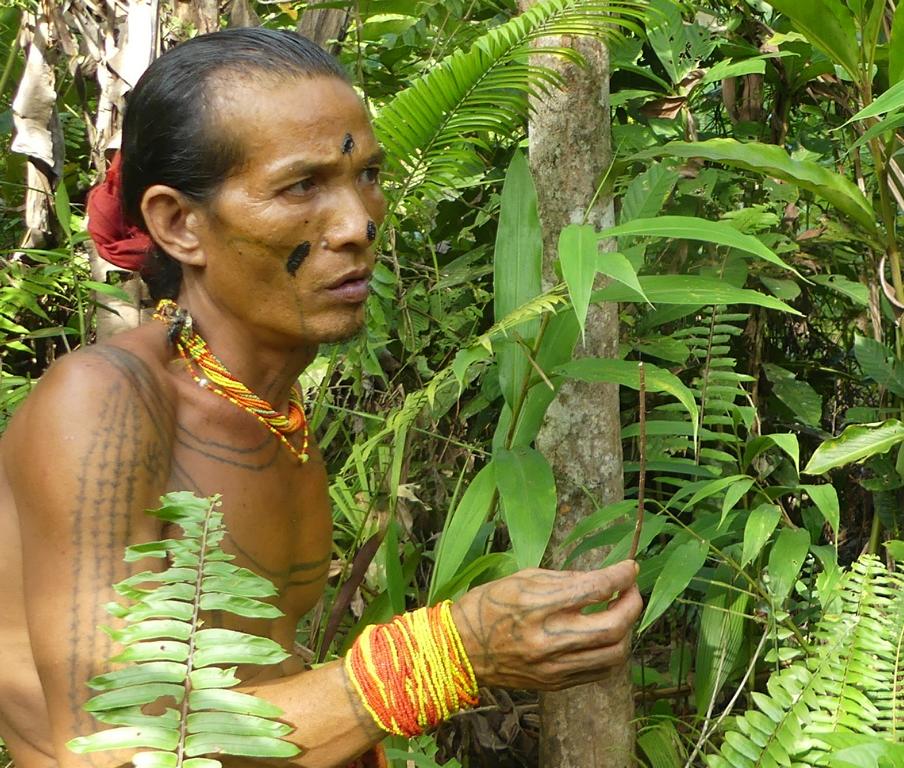
We collected a roughly 20 cm / 8’’ long portion of the root. The active ingredient is contained in the white milk within the root wood.
Poisonous chemical compounds of Laining
The sap extracted from the roots includes several polycyclic toxins. The most abundant is benzopyran rotenone. Rotenone acts as a neurotoxin and also as a haematoxin. It severely interrupts the contact spots of the somato-motoric nerves to the muscles, creating convulsions, which are finally followed by paralysis. This can be lethal even to big animals. The effectiveness is increased 20-fold with the presence of lipoid substances. Capsicum pods contain it! It is also a potent fish poison that destroys the gill epithelia, preventing oxygen absorption.
Daro; Capsicum frutescens
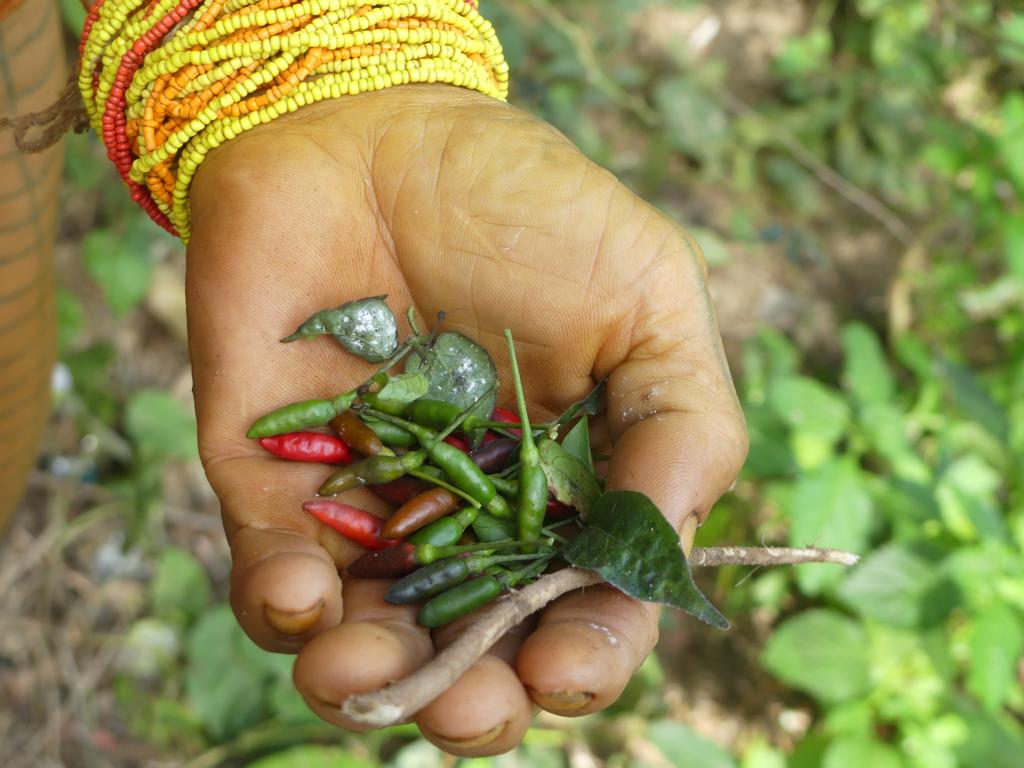
Daro is the vernacular Mentawai name for chili, which they use only as a component for arrow poison, not as a spice. Aman Aru used a Capsicum frutescens variety called ‘Cabai Rawit Hijau’ in Bahasa Indonesia. Capsicum frutescens has small fruits pointed upwards and a pungency of 80.000 – 100.000 Scoville heat Units.
Active chemical compounds of Daro
The pods of this chili contain a high amount of capsaicinoids. Other chemically active compounds are lipoids, flavonoids, and ascorbic acid. The capsaicinoids affect the contacts of the nerves connected to the skin. That leads to an expansion of the capillaries, which accelerates blood circulation. Hence, it also accelerates the distribution of the arrow poison within the body. The lipoids greatly magnify the interruption of the nerve spots in the muscles.
Poison preparation
Processing the ingredients
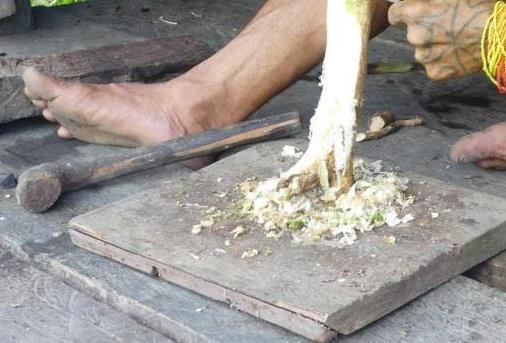
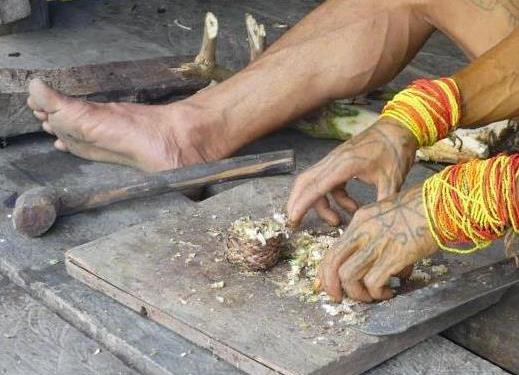
After scrapping down and removing the outer brown bark of the Daggi wood, the inner white bark was scrapped from the wood. These white shavings were densely stuffed into a flexible rotang basket ring. When the basket ring was densely filled, one portion of the poison to be produced at this session was measured. These shavings were removed from the basket ring and returned to the wooden tray.
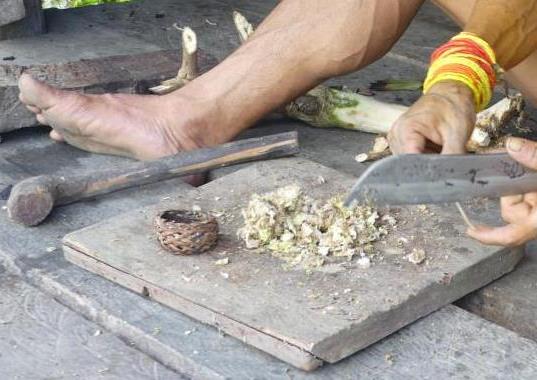
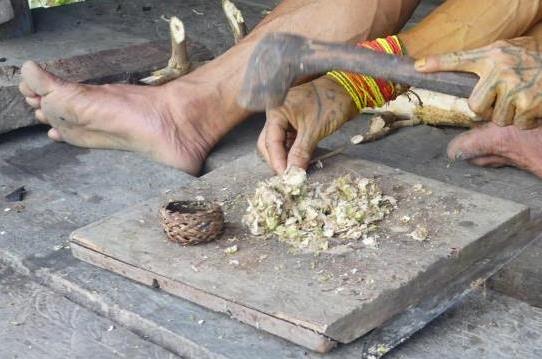
From the 20 cm / 8’’ long piece of Laining root, a 6 cm / 2 3/8’’ piece was cleaned off its brown bark. This small and thin piece of root was smashed with a wooden mallet within the pile of Daggi shavings. Aman Aru thoroughly mixed Daggi shavings and Laining root pieces with his fingers to achieve an even distribution of both constituents.

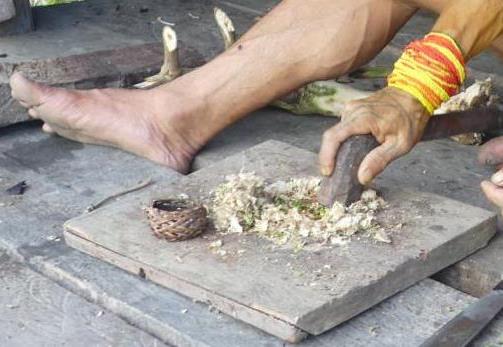
Next, 15 pods of Daro chili and five shredded Daro leaves were added to the mix and smashed, squashed, and ground with the mallet’s head. After all three plant matter were uniformly distributed, the final mix was ready for pressing.
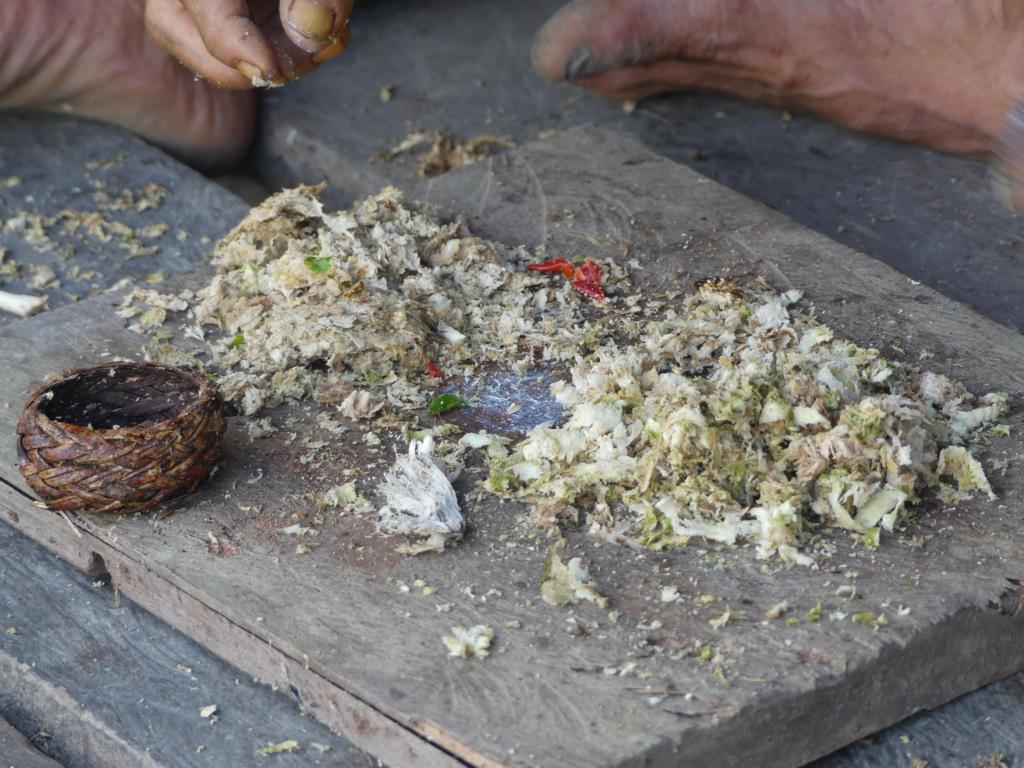
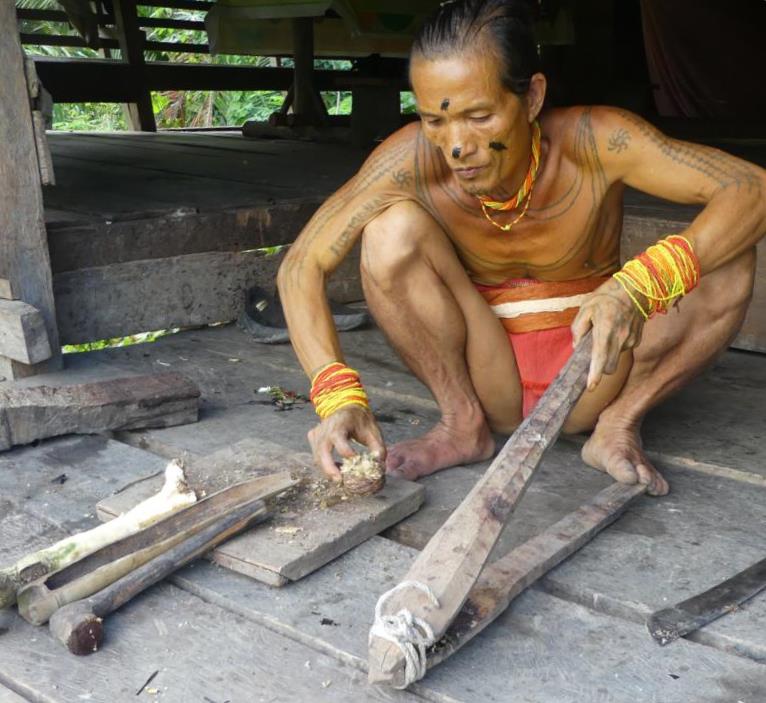
Pressing the poisonous liquid and applying it to the arrows
The mixture was then divided into two heaps. One part was put into the rotang basket ring and was pressed with a simple wooden lever press. This process can be seen in the following video clip.
The press cake was removed and replaced by the second heap of mixed virgin material, which was also pressed. After removing that press cake, both were mixed again, divided into two, and each pressed again. Therefore, pressing was done four times: twice with virgin material and twice with press cake.
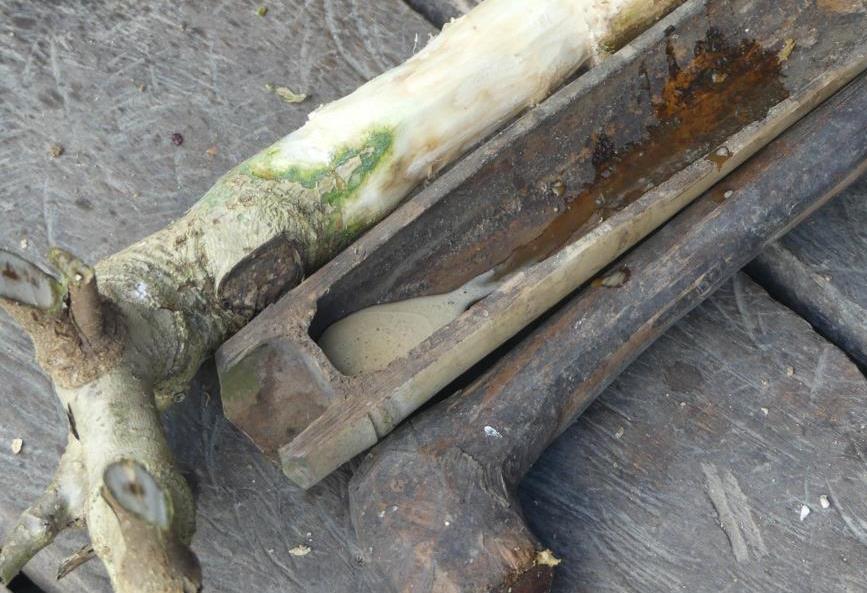
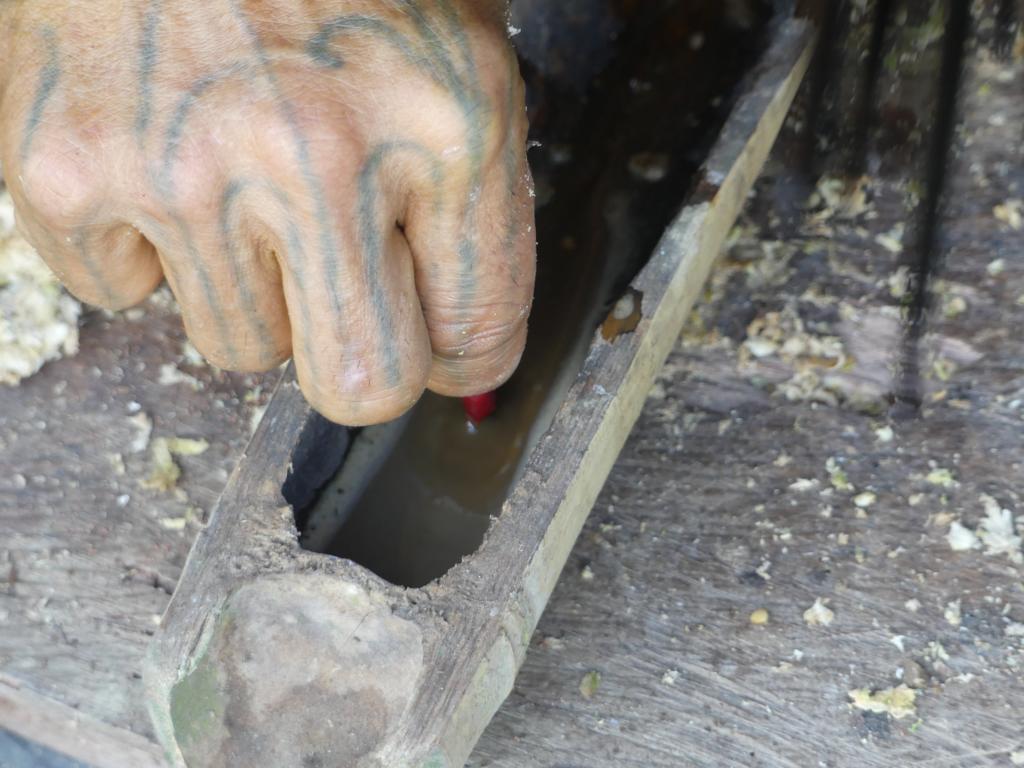
The liquid poison was collected in a split piece of bamboo. Before using it, Aman Aru tested its strength. He took one chili pod, pulled out the stem base, and dipped the open chili end into the poison.
The poison is regarded to be strong enough for hunting if a sizzling ring of bubbles forms immediately around the dipped-in chili. This ring of bubbles will move away from the chili with a speed of about 2 cm / 3/4’’ per second. In our case, it was strong enough. If not, the whole process has to be repeated with new plant parts.
About 10 cm down from the arrow tips, this liquid poison will now be painted and dried over a small fire outside the Uma. It is just a drying process over moderate heat, with no intention of smoking the poisoned part of the arrows.
After drying, the arrows will be painted a second time with liquid poison and then dried again. The poison on unused arrows will be renewed every three months.
Cleaning hands after handling the poisonous components
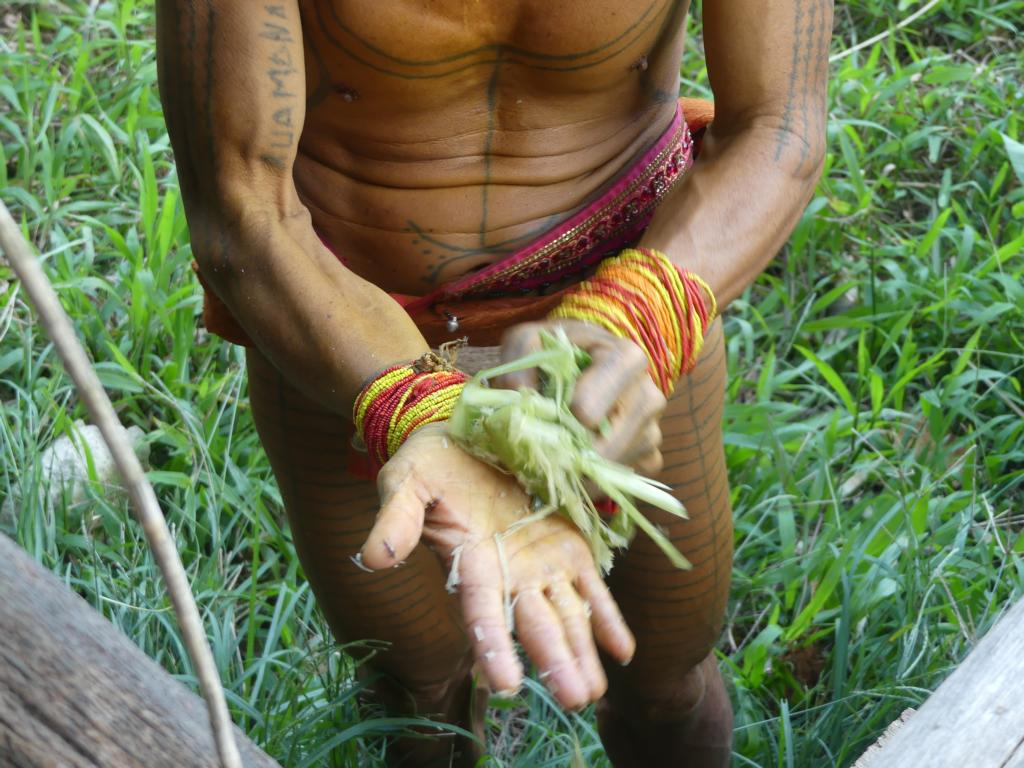
After producing the arrow poison, everybody who has touched either Daggi or Laining has to clean his hands with White Ginger Lily’s stems, as described in this article on our website.
Effect of the poison
An important parameter of arrow poison is that it is readily and rapidly soluble in blood. As the Mentawai poison is highly soluble in water, it will start to act immediately after hitting the bloodstream of the game animals.
According to Zahorka (link seen above) and verbal information from Aman Aru, game animals like monkeys who are hit by an arrow emit a scream and appear to become paralyzed immediately. This is regardless of which part of the body was hit. The faces of these animals become contorted with pain, and their bodies start to twitch. This state lasts one minute or more while the condition worsens. The animals then lose consciousness at an accelerating rate—death results mainly from cardiac failure, most probably by respiratory arrest.
The boiled or fried meat of game animals killed with this poison is edible. Mentawai people chop every animal for food into small pieces and cook the meat thoroughly. They do not even cut out the area where the arrow was stuck.
Treatment of poison wounds
If a human gets wounded by the discussed arrow poison, his chances of survival are very slim. Mentawai shamans see such a person as doomed to death.
Literature, however, recommends the following treatment:
‘The victim can only survive by immediate, professional treatment, which consists of suctioning the wound (using a suction glass) and injections or wet dressings of potassium permanganate after prior blockage of the blood circulation, to prevent the blood from flowing and penetrating further into the body.’
This is a very optimistic view, as the hunting areas are many hours away from the Uma, and the Uma is many hours away from the next clinic. Suction glasses and potassium permanganate are not available in time. The medical skills and knowledge of Mentawai shamans about herbal medicine are excellent. But in the forests, there is no timely treatment available for arrow poison in one’s body.
Lessons learned from Mentawai arrow poison:
- Mentawai arrow poison classically consists of three parts: Tabernaemontana peduncularis, Derris elliptica, and Capsicum frutescens.
- Ipoh (Antiaris toxicaria) latex is not used on Siberut Island.
- The ingredients are ground together, and their juice is extracted.
- Poisonous juice is applied to arrows multiple times.
- This poison is highly water- and blood-soluble and will immediately act in the game’s body.
- The meat of the game killed with this poison is edible.
.



